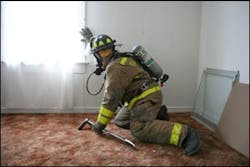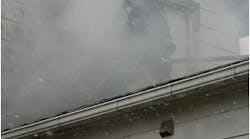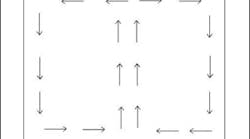High Risk/High Reward - Searching for Life on the Fireground - Part 1
Preparations for performing fireground search must be mental as well as physical.
This article is a part of a series of articles focused on considerations for primary search.
Each year, we continue to lose approximately 100 firefighters in the line of duty. Running out of air after becoming lost and disoriented, while performing a search, is the second leading cause of firefighter deaths and injuries while operating on the fireground. The search of a burning structure is a firefighting basic and falls into the category of subject areas that firefighters should spend a majority of their training time.
As the job of firefighting changes, performing aggressive searches for trapped occupants is becoming more of a low frequency event with high risk potential. The subject areas of risk versus benefit analysis and size-up are directly related to the effectiveness of search efforts on the fireground. This series of articles will slightly touch on their importance but will try to concentrate on the actual operations of search once committed to the interior.
Searches for the rescue of trapped occupants are often performed under the most adverse conditions where a matter of even seconds can mean the difference between success and failure. It must not be forgotten however, that the most effective life-saving effort on the fireground is to advance a hoseline and attack the fire. This may include protecting egress paths for trapped victims as well as eliminating the danger of the fire itself. Search efforts should always be accomplished simultaneously with an aggressive fire attack and ventilation efforts if possible.
Preparations for performing fireground search must be mental as well as physical. Firefighters performing this hazardous task on the fireground need to be confident in their abilities as well as trained to a level that will allow them to operate within the proper risk management principles. Properly worn PPE, SCBA, radio, two handlights, personal rope (at least 30 feet), forcible entry (exit) tools and door chocks are the minimum necessary equipment.
Handlights need to be powerful enough to penetrate through smoke and should have a shoulder strap or clip to allow hands-free operation. A buckle-type strap can be advantageous in case a firefighter gets entangled while searching or wants to remove the light to place it in a location of orientation.
Thermal imaging cameras (TICs) are also a great addition to the arsenal if available but must not be relied on 100 percent. They are a battery powered tool that can fail, they should be used to supplement and aid in the search. Traditional search techniques should never be abandoned when using a TIC. The forcible entry tools chosen must also be selected based upon the type of building construction or occupancy that is going to be searched. Remember, not only are these tools to gain entry but also to make exit in an emergency if needed.
Using Your Size-Up To Read The Floor Plan
No matter what tactic is used for the search effort, focus needs to be on the overall big picture of the fireground and not just the rescue when committing our people to these situations. A thorough risk/benefit analysis needs to be performed each time personnel are committed to rescue operations and must be continual throughout the incident to prevent and overcome tunnel vision. Risk/benefit analysis must also be continual since the fireground is dynamic and ever changing as the incident progresses. The probability of the success of an operation must be considered in relation to the degree of risk presented. Incident size-up is the first step in establishing this assessment. This initial assessment will serve as the foundation for all decisions made.
Sadly, the question of, "is there still a realistic chance that the environment is survivable?" must be considered prior to committing firefighters.
Size-up for performing a search should begin well before an alarm is received. Most homes within communities have floor plans that are standard to the style of home (ranch, bungalow, cape cod, brownstone etc.) unless major renovations have taken place. Drawings of floor plans of new developments can often be readily obtained from builders during the construction phase as they are often included in the sales brochures. These can be looked at and discussed prior to getting an incident. Firefighters should make it a point to learn layouts of buildings within their response areas. This can be accomplished by taking a quick look after calls where entry is permitted such as medical runs, false activated alarms, etc.
Before entering the structure read the building and fire conditions. Visualizing the exterior can offer a general layout of the interior floor plan and provide valuable information on possible egress points if things go wrong during the interior search efforts. Soil/vent pipes will often signify bathrooms which are normally located off main hallways that contain bedrooms, skylights often above staircases; all important information for the vent team as well as the search team. Window design can also provide clues to the use of a particular area.
Firefighters must remain aware, however, that these generalities can be false all depending on what changes (legally or illegally) that the occupant may have made on their own to the interior. Extreme hazards, such as swimming pools in living areas and non-code compliant partitions, have all played contributing roles in fireground close calls and line of duty deaths.
Know where the fire has been, where it is at, and where it is going before committing to the search. Building construction can also give significant clues as to how long crews will have to conduct the search - an example being that wood-frame construction will attribute to rapid fire spread while a fire resistive building will hold heat more readily but will allow more time prior to structural integrity being lost.
Firefighters should always maintain awareness of their position within a building, along with the location of objects and furniture that is encountered within as well as fire conditions. If a search pattern starts to the left, continue to the left. Do not change to a right handed pattern once started. Actions such as this are what lead to disorientation. (The only exception to this is if a firefighter is turning around to exit back along the path that they entered.)
Doors and windows are survival landmarks that are important to every firefighter operating inside structures. For this reason, it is important that firefighters sweep high enough on the wall to locate the door handle or window sill and make a mental note of its location. Doors encountered during a search should also be closed if they will help contain the fire from your position or prevent the fire conditions from venting through the path taken for entry. If a firefighter is following a wall for a search, it is important that they maintain contact with the wall. Moving off the wall can lead to disorientation or missing possible egress points.
Feel around furniture and obstacles and return to the wall as quickly as possible. Moving obstacles and furniture out of your way while searching is a dangerous practice. Doing so can lead to becoming disorientated as well as impede efforts for a quick escape if necessary. In addition, the piece of furniture that you throw out of your way may end up on top of the victim that you are searching for, making it more difficult to locate them.
Interior Features Can Provide Insight in Limited Visbility
Conditions can deteriorate rapidly, sometimes without warning, knowing the location of the closest door or window is a self-survival basic. Firefighters should draw a picture in their mind of their surroundings as they move through a building with limited visibility. Some ways of accomplishing this are through features that are unique to areas within a building such as furnishings, floor coverings and door swings. Certain furnishings will be unique to specific areas - refrigerators and tables to kitchens, beds to bedrooms etc. Floor coverings such as tile are generally in bathrooms or kitchens while carpeting can be pinpointed to areas such as the living room or bedrooms.
In a commercial structure, tile may be located in main aisles which could lead to exits and carpeting could be located in work or display areas. Door swings are also possible indicators for orientation points. Generally speaking, doors to bedrooms and bathrooms will swing inward as well as entrances and exits in residential structures while closet doors will swing outward to allow more space for storage. In a commercial structure, entrances and exits should swing outward. Again, these are generalities and may not always be true depending on what has been changed or renovated in a building and if it was inspected under a specific set of building codes. Searching firefighters in multi-family and commercial type occupancies must also be very wary of any outward swinging doors that they encounter on the interior as these can possibly lead to elevator shafts and other hazards.
An excellent training exercise to reinforce "mental mapping" with firefighters is to set up a room or area with furniture and obstacles and have them enter with their SCBA facepieces covered and perform a search of the area. Once they exit the area, they should remove their gear and sketch the area on a piece of paper that they searched. After drawing the area, they should be allowed to enter the area to compare their drawing to the actual area.
The search of fire buildings can be one of the most rewarding actions taken on the fireground but can also be the most hazardous duty performed. The next article in the series will focus on the search process itself. Until then; are you prepared to meet the challenge if presented on your tour of duty?
- Learn from Battalion Chief Pindelski Live: He will be presenting "Saving Your Crew Tonight-Why Are We Still Losing Firefighters" at Firehouse Expo in July.
JEFFREY PINDELSKI, a Firehouse.com Contributing Editor, is a 18-year veteran of the fire service and currently serves as a battalion chief with the Downers Grove, IL, Fire Department. Jeff is a staff instructor at the College of Du Page and has been involved with the design of several training programs dedicated to firefighter safety and survival. Jeff is the co-author of the text R.I.C.O., Rapid Intervention Company Operations and is a revising author of the 3rd edition of the Firefighter's Handbook. He particpated in Training & Tactics Talk on [email protected] To read Jeff's complete biography and view his archived articles, click here. You can reach Jeff by e-mail at [email protected].








